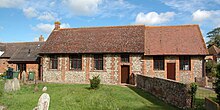Sydenham, Oxfordshire
| Sydenham | ||
|---|---|---|
Shire county | ||
| Region | ||
| Country | England | |
| Sovereign state | United Kingdom | |
| Post town | Chinnor | |
| Postcode district | OX39 | |
| Dialling code | 01844 | |
| Police | Thames Valley | |
| Fire | Oxfordshire | |
| Ambulance | South Central | |
| UK Parliament | ||
| Website | Sydenham Village | |
Sydenham is a village and
Manor
Sydenham was settled in the
In the 12th century the de
In 1542
Church and chapels


Church of England
By 1185–86 Sydenham was a chapelry of the
Early in the 14th century a Decorated Gothic east window was inserted in the chancel and a rood screen and rood loft were added. Late in the 15th century the nave was given a hammerbeam roof.[2] The rood screen and loft were removed in 1840.[2] In the chancel is a set of Medieval corbels that formerly supported a Lenten veil to screen the altar. Such veils were discontinued in the English Reformation, and these corbels are a rare survival.[5]
Sherwood and Pevsner state that the architect John Billing restored St Mary's in 1856,[4] but the Victoria County History states that the restoration was in 1877.[2] By both accounts the tower was rebuilt, the chancel and nave lengthened and a vestry and south porch added.[4][2] the Victoria County History adds that the tower and its arches were moved some distance to the west.[2] The two lancet windows west of the south porch were added during the restoration, and the 14th-century style west window of the nave was probably added at the same time.[4] The church is a Grade II* listed building.[5] Its parish is now part of a single benefice with the parishes of Aston Rowant, Chinnor and Crowell.[6]
Non-conformist
There were
Social and economic history



By the 12th century a brook through the centre of the parish had been dammed to form a millpond to drive a
In 1849 a
By 1851 the village had two
Notable residents
BBC presenter Fiona Bruce and her husband Nigel Sharrocks have a second home in Sydenham.[8][9][10]
References
- Neighbourhood Statistics. Office for National Statistics. Retrieved 22 August 2015.
- ^ a b c d e f g h i j k l m n o p q r s t Lobel 1964, pp. 116–127.
- ^ a b Lobel 1964, pp. 55–80.
- ^ a b c d e Sherwood & Pevsner 1974, p. 801.
- ^ a b Historic England. "Church of St Mary (Grade II*) (1180738)". National Heritage List for England. Retrieved 21 June 2013.
- ^ Archbishops' Council (2010). "Sydenham: St Mary Sydenham". A Church Near You. Church of England.
- ^ "Sydenham". Oxfordshire Churches & Chapels. Brian Curtis.
- ^ Wallis, Lucy (18 December 2003). "Fiona Bruce's wild days". BBC News Online. Archived from the original on 29 January 2009. Retrieved 10 April 2020.
- ^ "The Belsize Story, Belsize Village | Home". www.belsizevillage.co.uk. Retrieved 28 December 2022.
- from the original on 16 October 2018. Retrieved 10 April 2020.
Although she's no green goddess herself, Fiona Bruce is delighted that the BBC recycles its 'ageing' presenters
Sources
- Lobel, Mary D, ed. (1964). A History of the County of Oxford. Victoria County History. Vol. 8: Lewknor and Pyrton Hundreds. London: Oxford University Press for the Institute of Historical Research. pp. 55–80, 116–127.
- Sherwood, Jennifer; ISBN 0-14-071045-0.
